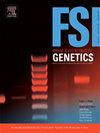A preliminary study on detecting human DNA in aquatic environments: Potential of eDNA in forensics
IF 3.2
2区 医学
Q2 GENETICS & HEREDITY
引用次数: 0
Abstract
Human environmental DNA (eDNA) application have not been fully applied or adequately considered in the fields of eDNA and forensics. Nonetheless, this technique holds great potential as a complementary tool for detecting human DNA in aquatic environments, particularly in cases involving crimes connect to such environments. However, the detectability or stability of eDNA can vary depending on several factors. Therefore, this preliminary study investigates the detection and degradation rates of human eDNA, as well as the recovery of nuclear short tandem repeat (STR) profiles and mitochondrial DNA (mtDNA) sequencing, using water samples from both saltwater and freshwater sources. To conduct the experiment, whole human blood was spiked into the water samples. Water samples were then filtered using a 5 µm pore size filter, and samples were collected at various time intervals up to 23 days. A human specific qPCR assay targeting HV1 region of human mtDNA was used to detect human eDNA. Results demonstrated that human eDNA remains detectable for up to 36 hours in freshwater samples and up 84 hours in saltwater samples. The limit of detection (LOD) of human eDNA, (205 copies/µl), was achieved after 60 hours in freshwater and 180 hours in saltwater samples. Partial STR profiles could be recovered up to 24 hours for freshwater and saltwater. Results from mtDNA sequencing indicate that full mtDNA profiles could be recovered from freshwater samples up to 48 hours and remained detectable up to 72 hours in saltwater. Overall, the findings of this study underscore the importance of considering and incorporating human eDNA analysis as a valuable tool in forensic practice. By harnessing the power of eDNA, law enforcement agencies can enhance their investigation capabilities, improve the accuracy of forensic reconstructions, and ultimately contribute to the resolution of cases involving aquatic environments. Further research and validation are needed to optimize and expand the utilization of eDNA techniques in forensic investigations.
关于在水生环境中检测人类 DNA 的初步研究:eDNA 在法医学中的潜力。
人类环境 DNA(eDNA)应用在 eDNA 和法医学领域尚未得到充分应用或充分考虑。尽管如此,这项技术作为检测水生环境中人类 DNA 的补充工具具有巨大潜力,尤其是在涉及与此类环境有关的犯罪案件中。然而,eDNA 的可检测性或稳定性会因多种因素而变化。因此,本初步研究利用海水和淡水水样,调查了人类 eDNA 的检测率和降解率,以及核短串联重复(STR)图谱和线粒体 DNA(mtDNA)测序的恢复情况。为了进行实验,在水样中添加了全人类血液。然后使用 5 微米孔径的过滤器过滤水样,并在不同的时间间隔收集水样,最长收集时间为 23 天。使用针对人类 mtDNA HV1 区域的人类特异性 qPCR 分析法检测人类 eDNA。结果表明,在淡水样本中可检测人类 eDNA 长达 36 小时,在海水样本中可达 84 小时。人类 eDNA 的检测限(LOD)在淡水样本中为 60 小时,在海水样本中为 180 小时。淡水和海水样本的部分 STR 图谱可在 24 小时内恢复。mtDNA 测序结果表明,淡水样本中完整的 mtDNA 图谱可在 48 小时内恢复,在海水样本中则可在 72 小时内检测到。总之,这项研究的结果强调了将人类 eDNA 分析作为法医实践中的一项重要工具的重要性。通过利用 eDNA 的力量,执法机构可以增强其调查能力,提高法医重建的准确性,并最终促进涉及水生环境案件的解决。要优化和扩大 eDNA 技术在法医调查中的应用,还需要进一步的研究和验证。
本文章由计算机程序翻译,如有差异,请以英文原文为准。
求助全文
约1分钟内获得全文
求助全文
来源期刊
CiteScore
7.50
自引率
32.30%
发文量
132
审稿时长
11.3 weeks
期刊介绍:
Forensic Science International: Genetics is the premier journal in the field of Forensic Genetics. This branch of Forensic Science can be defined as the application of genetics to human and non-human material (in the sense of a science with the purpose of studying inherited characteristics for the analysis of inter- and intra-specific variations in populations) for the resolution of legal conflicts.
The scope of the journal includes:
Forensic applications of human polymorphism.
Testing of paternity and other family relationships, immigration cases, typing of biological stains and tissues from criminal casework, identification of human remains by DNA testing methodologies.
Description of human polymorphisms of forensic interest, with special interest in DNA polymorphisms.
Autosomal DNA polymorphisms, mini- and microsatellites (or short tandem repeats, STRs), single nucleotide polymorphisms (SNPs), X and Y chromosome polymorphisms, mtDNA polymorphisms, and any other type of DNA variation with potential forensic applications.
Non-human DNA polymorphisms for crime scene investigation.
Population genetics of human polymorphisms of forensic interest.
Population data, especially from DNA polymorphisms of interest for the solution of forensic problems.
DNA typing methodologies and strategies.
Biostatistical methods in forensic genetics.
Evaluation of DNA evidence in forensic problems (such as paternity or immigration cases, criminal casework, identification), classical and new statistical approaches.
Standards in forensic genetics.
Recommendations of regulatory bodies concerning methods, markers, interpretation or strategies or proposals for procedural or technical standards.
Quality control.
Quality control and quality assurance strategies, proficiency testing for DNA typing methodologies.
Criminal DNA databases.
Technical, legal and statistical issues.
General ethical and legal issues related to forensic genetics.

 求助内容:
求助内容: 应助结果提醒方式:
应助结果提醒方式:


